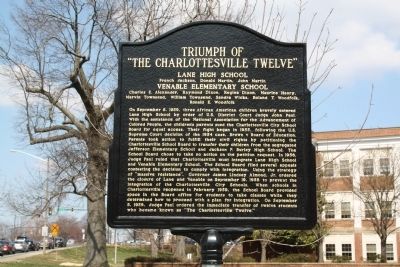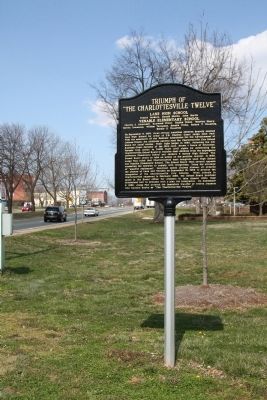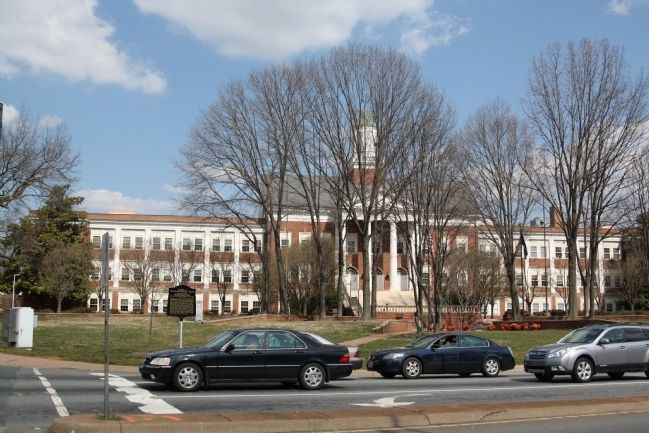North Downtown in Charlottesville, Virginia — The American South (Mid-Atlantic)
Triumph of “The Charlottesville Twelve”
Lane High School. French Jackson, Donald Martin, John Martin.
Venable Elementary School. Charles E. Alexander, Raymond Dixon, Regina Dixon, Maurice Henry, Marvin Townsend, William Townsend, Sandra Wicks, Roland T. Woodfolk, Ronald E. Woodfolk.
On September 8, 1959, three African American children bravely entered Lane High School by order of U.S. District Court Judge John Paul. With the assistance of the National Association for the Advancement of Colored People, the children’s parents sued the Charlottesville City School Board for equal access. Their fight began in 1955, following the U.S. Supreme Court decision of the 1954 case, Brown v Board of Education. Parents took action to fulfill their civil rights by petitioning the Charlottesville School Board to transfer their children from the segregated Jefferson Elementary School and Jackson P. Burley High School. The School Board chose to take no action on the petition request In 1956, Judge Paul ruled that Charlottesville must integrate Lane High School and Venable Elementary School. The School Board filed several appeals contesting the decision to comply with integration. Using the strategy of “massive resistance,” Governor James Lindsey Almond, Jr. ordered the closure of Lane and Venable on September 19, 1958 to prevent the integration of the Charlottesville City Schools. When schools in Charlottesville reopened in February 1959, the School Board provided space in the Board office for students to take classes while they determined how to proceed with a plan for integration. On September 5, 1959, Judge Paul ordered the immediate transfer of twelve students who became known as “The Charlottesville Twelve.”
Erected 2012 by City of Charlottesville.
Topics. This historical marker is listed in these topic lists: African Americans • Civil Rights. A significant historical month for this entry is February 1959.
Location. 38° 2.03′ N, 78° 29.02′ W. Marker is in Charlottesville, Virginia. It is in North Downtown. Marker is at the intersection of McIntire Road and Preston Avenue, on the right when traveling south on McIntire Road. Marker is at the sidewalk and facing the intersection in front of the Albemarle County Office Building, formerly Lane High Shoool. Touch for map. Marker is at or near this postal address: 401 McIntire Road, Charlottesville VA 22902, United States of America. Touch for directions.
Other nearby markers. At least 8 other markers are within walking distance of this marker. Jefferson School (approx. 0.2 miles away); Together We Grow (approx. 0.2 miles away); Nelson Sanitorium (1895-1902) (approx. ¼ mile away); Greater Downtown (approx. ¼ mile away); Swanson v. University of Virginia (approx. ¼ mile away); Sacajawea (approx. ¼ mile away); Catholic Church of the Holy Comforter (approx. ¼ mile away); Monticello Wine Company (approx. 0.3 miles away). Touch for a list and map of all markers in Charlottesville.
More about this marker. Marker is a one-sided marker, with the blank face towards the former Lane High School, now the Albemarle County Office Building.
Related markers. Click here for a list of markers that are related to this marker. This is a list of Brown v. Board of Education markers.
Also see . . .
1. On Brown's 50th: Why Charlottesville Schools Were Closed. 2004 article by Lisa Provence. “Julia Martin is 80 and elegant in the Lankford Avenue home where she’s lived since 1947. She signed on to the Allen lawsuit when her oldest son was attending all-black Burley on Rose Hill Drive. She, too, objected to the idea of her children walking by one high school—Lane—to get to another. Another thing that rankled Martin was weather closures. Because Albemarle County kids—whose buses had to travel country roads—[also] attended Burley, bad weather often closed the school, even if city residents could get there with no difficulty. ‘I paid city taxes,’ says Martin. ‘After a while, it hit me. Why should I be ruled by the county?’ Martin was working as a domestic, and her husband, John, was a waiter at Farmington Country Club when they joined the lawsuit. ‘I didn’t think I was wrong,’ she says. And as for her children, she says, ‘I wasn’t afraid anyone would hurt them.’ She pauses. ‘Maybe I was young and foolish’.” (Submitted on March 31, 2013.)
2. Decades Later, A Diploma. 2013 Washington Post article by Susan Svrluga. “It’s a letter her father wrote to her on her birthday in 1986, just after the first black lieutenant governor took office in Virginia and the Rev. Martin Luther King Jr.’s birthday became a national holiday. Change had come in part, he wrote, ‘because of the “small crack” that you placed in the rock of segregation’.” (Submitted on May 29, 2013.)
Credits. This page was last revised on February 1, 2023. It was originally submitted on March 31, 2013, by J. J. Prats of Powell, Ohio. This page has been viewed 1,222 times since then and 60 times this year. Photos: 1, 2, 3. submitted on March 31, 2013, by J. J. Prats of Powell, Ohio.


